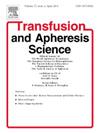Effect of temporary storage of cryopreserved cellular therapy products at −80⁰ celsius on cell recovery and viability
IF 1.4
4区 医学
Q4 HEMATOLOGY
引用次数: 0
Abstract
Cellular therapy (CT) involving the transplantation of hematopoietic progenitor cells (HPC) is a treatment modality for both benign and malignant disorders. All autologous products require cryopreservation while allogeneic product cryopreservation became more common during the Coronavirus disease 2019 pandemic. Cells are stored in liquid nitrogen (LN2) freezers which can malfunction and products may have to be temporarily stored in a mechanical −80 °C freezer if additional LN2 freezer space is not available. The practice of temporary short-term −80 °C storage is present but there is no study to show that the product is unaffected by the temporary storage at a significantly warmer temperature. In this study, we identified previously collected CT products that were cryopreserved for now-deceased recipients that had remaining cryovials with aliquots of products for quality control purposes. Vials from 20 collections were split into 4 groups of 5 in with one vial placed in temporary storage at −80 °C for 2–5 weeks before returning to LN2 storage while another vial remained in LN2 storage for the entire duration of the study. The vials were then simultaneously thawed, processed, and evaluated for total nucleated cell (TNC) and CD34 + cell count and TNC and CD34 + cell viability to determine if there were any differences induced by temporary −80 °C storage. No statistically significant differences were seen after 4 weeks of −80 °C storage; however, after 5 weeks, a statistically significant decrease in TNC viability and viable TNC count, but not CD34 + cell viability and viable CD34 + cell count was observed. These results provide some reassurance to CT processing labs that if there is a failure in their LN2 storage for cryopreserved products, these products may be safely stored at −80 °C for up to 4 weeks and returned to LN2 storage without compromising CD34 + cell viability.
在-80⁰摄氏度下暂时储存低温保存的细胞治疗产品对细胞恢复和活力的影响
细胞疗法(CT)涉及造血祖细胞(HPC)的移植,是良性和恶性疾病的一种治疗方式。所有自体产品都需要低温保存,而异体产品的低温保存在 2019 年冠状病毒疾病大流行期间变得更加普遍。细胞储存在液氮(LN2)冷冻箱中,而液氮冷冻箱可能会出现故障,如果没有额外的液氮冷冻空间,产品可能不得不暂时储存在机械式-80 °C冷冻箱中。目前已有-80 °C短期临时储存的做法,但没有研究表明产品在温度明显更高的环境中临时储存不会受到影响。在这项研究中,我们确定了以前为现已去世的受者冷冻保存的 CT 产品,这些产品的剩余冷冻瓶中有用于质量控制的等分产品。我们将 20 个收集的样品瓶分成 4 组,每组 5 个,其中一个样品瓶在 -80 °C 下暂时保存 2-5 周,然后再返回 LN2 保存,而另一个样品瓶在整个研究期间都保持在 LN2 保存状态。然后同时解冻、处理和评估小瓶中的总核细胞(TNC)和 CD34 + 细胞计数以及 TNC 和 CD34 + 细胞存活率,以确定-80 °C临时储存是否会引起任何差异。在-80 °C储存4周后,未发现有统计学意义的差异;但在5周后,观察到TNC存活率和存活的TNC计数有统计学意义的下降,而CD34 +细胞存活率和存活的CD34 +细胞计数没有下降。这些结果为 CT 处理实验室提供了一些保证,即如果冷冻保存产品的 LN2 储存发生故障,这些产品可以安全地在 -80 °C 下储存长达 4 周,然后再返回 LN2 储存,而不会影响 CD34 + 细胞的存活率。
本文章由计算机程序翻译,如有差异,请以英文原文为准。
求助全文
约1分钟内获得全文
求助全文
来源期刊
CiteScore
3.60
自引率
5.30%
发文量
181
审稿时长
42 days
期刊介绍:
Transfusion and Apheresis Science brings comprehensive and up-to-date information to physicians and health care professionals involved in the rapidly changing fields of transfusion medicine, hemostasis and apheresis. The journal presents original articles relating to scientific and clinical studies in the areas of immunohematology, transfusion practice, bleeding and thrombotic disorders and both therapeutic and donor apheresis including hematopoietic stem cells. Topics covered include the collection and processing of blood, compatibility testing and guidelines for the use of blood products, as well as screening for and transmission of blood-borne diseases. All areas of apheresis - therapeutic and collection - are also addressed. We would like to specifically encourage allied health professionals in this area to submit manuscripts that relate to improved patient and donor care, technical aspects and educational issues.
Transfusion and Apheresis Science features a "Theme" section which includes, in each issue, a group of papers designed to review a specific topic of current importance in transfusion and hemostasis for the discussion of topical issues specific to apheresis and focuses on the operators'' viewpoint. Another section is "What''s Happening" which provides informal reporting of activities in the field. In addition, brief case reports and Letters to the Editor, as well as reviews of meetings and events of general interest, and a listing of recent patents make the journal a complete source of information for practitioners of transfusion, hemostasis and apheresis science. Immediate dissemination of important information is ensured by the commitment of Transfusion and Apheresis Science to rapid publication of both symposia and submitted papers.

 求助内容:
求助内容: 应助结果提醒方式:
应助结果提醒方式:


